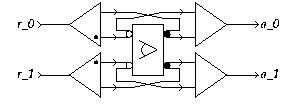EDIS:
Guide |
FAQ |
New |
Search |
Bibliography |
Index |
Feedback
Mutual-Exclusion Element
Informal
A Mutual-Exclusion Element is a
handshake component with
two passive 4-phase handshake ports.
The second to third phase intervals do not overlap.
The four phases of a handshake with a Mutual-Exclusion Element
can be interpreted as request, grant, done, and acknowledge (of done)
respectively.
The grant outputs on the ports are mutually exclusive.
When a Mutual-Exclusion Element receives two requests,
it will grant exactly one of them (and delay the other).
The specification leaves the choice open.
Often there is a fairness requirement
on this choice:
if a choice situation arises `infinitely often'
then both requests are granted `infinitely often'.
Schematic diagram
for a Mutual-Exclusion Element:

[Zoom|FIG]
XDI state graph
for a Mutual-Exclusion Element:

[Zoom|FIG]
Specification in XDI model.
Specification in Verdect:
define ME( r0?, a0!, r1?, a1! ) =
|[ x0, y0, x1, y1 ::
pref *[ r0?; x0; a0!; r0?; y0; a0! ]
|| pref *[ r1?; x1; a1!; r1?; y1; a1! ]
|| pref *[ x0; y0 | x1; y1 ]
]|
end
Also available through this link
The following specification in DI Algebra is different from the
specification given above for the same reasons as for the
Nacking Arbiter.
Specification in DI Algebra:
I = { r0, r1 }
O = { a0, a1 }
ME = [ r0? -> a0! ; r0? ; a0! ; ME
, r1? -> a1! ; r1? ; a1! ; ME
]
Also available through this link
This is shown by this
report.
An alternative specification in DI Algebra uses alternations:
Specification in DI Algebra:
I = { r0, r1 }
O = { a0, a1 }
ME = [ r0? -> a0! ; r0? ; a0!; ME
, r1? -> a1! ; r1? ; a1!; ME
]
[{r0},{a0}]
[{r1},{a1}]
Also available through this link
This comparison
shows that this specification
is correct.
XDI Report.
The roles of the two ports can be interchanged:
ME(a, b) = ME(b, a)
A Mutual-Exclusion Element is not output deterministic,
since there is an output choice in state 5.
The output nondeterminism is dynamic.


